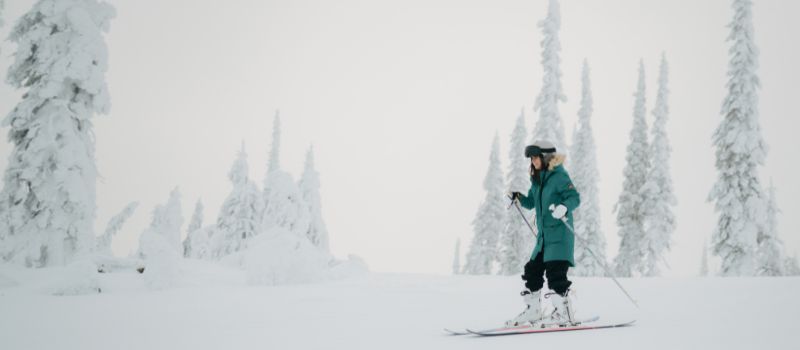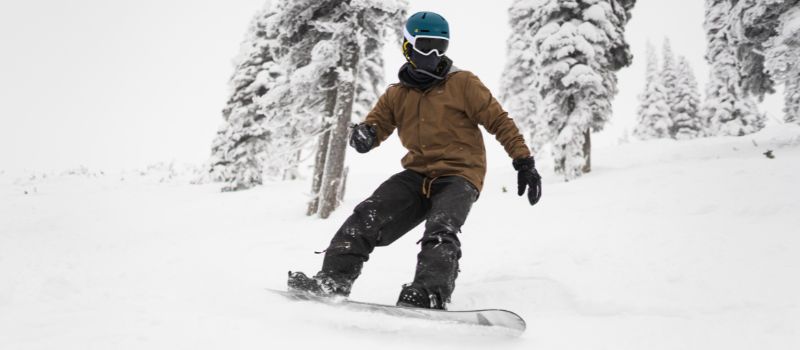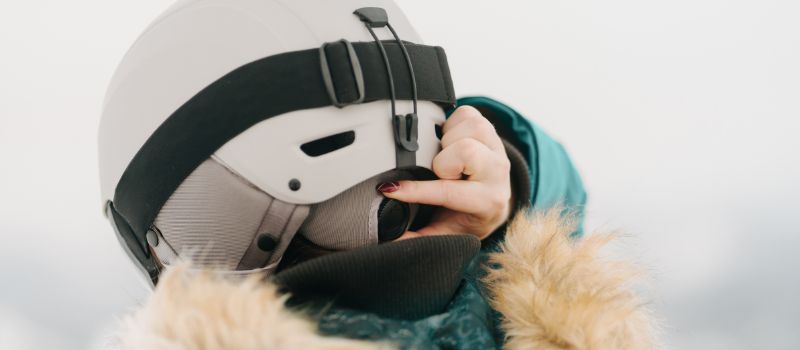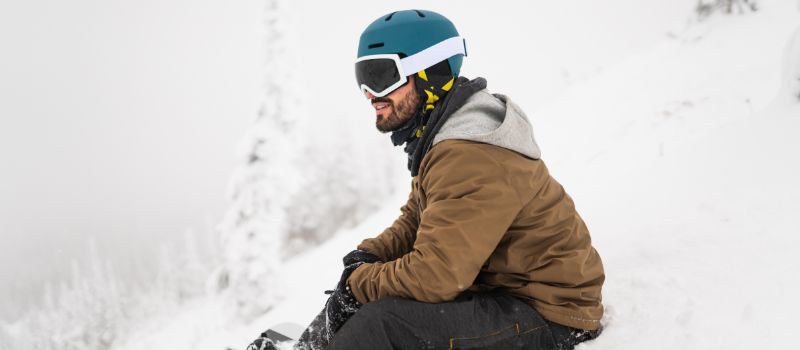How to Choose the Right Ski/ Snowboard Helmet

With the way skiers carve effortlessly through trees and over groomers, it’s easy to think there’s no way to get hurt on the mountain. Truth is, there are obstacles everywhere on the hill. It’s easier to “ring your bell” than you believe while skiing.
That’s why wearing a helmet is such a necessity. Skiing and snowboarding are legitimately dangerous activities, and there’s a serious risk of traumatic brain injury every day on the mountain.
In this article, we’ll walk you through the decision making process of how to shop for a new ski or snowboard helmet. Everything you need to know how to make a smart ski helmet purchase is right here.
How to Choose Ski/Snowboard Helmets
If you’re still asking yourself, “will any helmet do?” then you’re in the right place. Ski helmets have a lot of features that set them apart from helmets for cycling, climbing, or motorsports. So what should you look for in a ski helmet?
You would think it would be simple to settle on one helmet since there are so many out there—that’s the unfortunate paradox of choice—however, we’ve listed a few features to watch out for to help you find your perfect match. Things like safety certifications, insulation, ventilation, visors, and additional features can make your helmet safer and more comfortable.
Here’s what to keep an eye out for when shopping for a ski helmet.
Is Cost a Factor?
The short answer is yes, cost is always a factor. As a general rule, it’s a good idea to not skimp on safety. Bringing something like a cheap bike helmet skiing is a bad decision. Not wearing a helmet is an even worse one.
That said, there are some pretty affordable helmets on the market that are totally sufficient for use at the resort. As long as your helmet has been lab tested or certified to be safe, it should keep you safe while riding.
Ski helmets range quite a bit in terms of cost. You can expect to pay anywhere from around $45 for a standard resort riding helmet, to upwards of $450 for a racing helmet.
When considering which helmet to buy, think about how you plan to use it. What kind of riding are you going to be doing? Most importantly, remember that any helmet is better than no helmet at all.
Safety Certifications and Features
Tested & Certified
While shopping, keep an eye out for these acronyms:
- ASTM
- BS/CE/EN
- CPSC
These are the main organizations that test materials for impact resistance. Why does that matter? Well, there’s a saying among skiers that goes something like this: “trees are hard, dude.”
If your helmet isn’t robust enough to not only withstand a serious impact, but absorb it, it’s not worth your time. Seeing one of these certifications lets you know your helmet has undergone testing for impact resistance.
This is especially important for ski helmets. Certain plastics can weather and deteriorate when they come into long-term contact with sun, water, and cold. Which, of course, are the three staples of winter conditions.
MIPS
MIPS (Multidirectional Impact Protection System) is a proprietary technology added on to some helmets. MIPS increases your helmet’s ability to absorb angular blows, which are a common cause of concussions and spinal injuries. Helmets with MIPS often cost more, but if you want extra protection, this is a great way to get it.
Solid Earmuffs
Another common safety add-on you’ll see are the solid shells that cover the ear muffs of racing helmets. This design offers almost a full 360 degree sphere of protection around your skull.
Because of the high speeds ski racers reach, this extra shielding is considered standard. But for regular downhill skiing, it’s generally unnecessary.

Features
Now that we know what makes a ski helmet good enough to use, let’s explore what makes it a ski helmet. Just looking at ski helmets, it’s immediately apparent that they’re different from helmets for other sports. But you won’t always get the same features on every helmet. Here’s what to look for when shopping.
Padded/Removable Earmuffs
The biggest characteristic that sets ski helmets aside visually is earmuffs. These are usually connected with a padded band that runs around the back of the neck. Sometimes these have a removable section over your ear so you can wear headphones more comfortably. Usually (but not always) the ear pads are removable.
Try to find a helmet with removable earmuffs. When the weather starts to warm in the spring, you’ll be sweating bullets if you can’t take them off.
Ventilation
While skiing, you will experience both the coldest of cold conditions and the sweatiest of hot conditions. When spring rolls around, the transition from a full jacket to a t-shirt can happen in the blink of an eye. This is one of the reasons why you’ll want a ventilated helmet.
But how much is too much ventilation? The answer is that good ski helmets (like the Retrospec Zephyr) have adjustable vents, so you can open or close them as much as you want.
Goggle Clip or Integrated Goggles
Ski helmets and goggles go together like peanut butter and jelly. Most helmets are designed to hold your goggles on, so that they don’t fly off if you fall.
For some helmets, this is a plastic clip. Others have a kind of rubber strap with snaps. Some more expensive helmets integrate with the goggles’ frames. Some skiers swear by this tech, while others think it doesn’t allow enough ventilation under their lenses.
Visor
Visors on ski helmets are mostly an aesthetic choice, but they can be helpful on sunny days. This makes the most difference when you find yourself hiking uphill with the sun in your face. Which, if you’ve never been touring, happens more often than you’d think on the skin track. If you plan on ski touring at all, we highly recommend finding a helmet with a visor.
Integrated Headphones
Another feature you’ll sometimes find in helmets are headphones that are fully integrated into the earmuffs - either bluetooth or wired. It can be nice not to have to fiddle with headphones while gearing up, but having headphones on all the time can also limit your ability to hear. And as we all know, not being able to hear a passing rider yell out a warning “LEFT!” is a recipe for disaster.
Chinstrap
Ski helmets have chin straps. This is pretty self explanatory, so we’ll leave it at that. Don’t buy a helmet that doesn’t have a chin strap, as it will almost definitely fly off, and then you won’t have a ski helmet any more.
Sizing Adjustment
Ski helmets come in generic sizes (small, medium, large, XL). The actual measurements that correspond to these sizes vary by brand – there’s no one-size-fits-all helmet sizing chart. In addition, most people don’t fit perfectly into one of these categories, so ski helmets have a fit system, which is typically band in the back that tightens so that the helmet fits snugly.

Nicer helmets, like the Retrospec Comstock, have an easy-to-use roller wheel that clicks into place. Try to find a helmet that’s easy to adjust. You’ll have to tweak it when you put on a face mask, or even after cutting your hair.
Materials
The standard materials used in ski helmets are ABS plastic and EPS. ABS (acrylonitrile butadiene styrene) is a high-tech impact-resistant plastic that composes the shell of the helmet.
EPS (expanded polystyrene) is a lightweight foam that fills the shell. The foam is what actually absorbs impacts to the skull. These are the modern industry-wide standards for making ski helmets. You should be cautious of anything not made of ABS and EPS.
Injection molded helmets are made of ABS plastic with EPS foam attached to the inside, which provides added protection against shock.
In comparison, in-molded helmets combine the shell and shock-absorbing foam in a single mold. These helmets are lighter, but less durable than injection molded helmets.
Finding the right helmet is a big decision and one that requires the right investigation. The more decision-based evidence you gather, the easier to pick the right one for you!
Ski Helmet FAQs
Q: What is a MIPS ski helmet?
A: MIPS (Multidirectional Impact Protection System) is a technology that protects you from angular blows, which commonly result in traumatic injury.
Q: Do ski helmets have headphones?
A: Some ski helmets have built-in headphones. Others have earmuffs that can be removed to fit better with earbuds.
Q: How much do ski helmets cost?
A: Quality ski helmets range from $45 to over $450. For downhill resort skiing, expect to pay $45-100.
Q: How long do ski helmets last?
A: The lifespan of a ski helmet is five years. UV light, cold weather conditions, and water will slowly degrade your helmet’s fit and materials, so be sure to replace it every five years, or if it gets cracked when crashing.
Q: Do I need a helmet for skiing?
A: YES. Helmets are strongly recommended for all skiers. Skiing is a high impact sport and TBI (traumatic brain injury) is very common among skiers and snowboarders.
Q: How do I measure my helmet size?
A: Wrap a tape measure around your head from your forehead to the back of your skull. A helmet should not bounce on your head if you jump up and down.
Q: Can I use a ski helmet for snowboarding?
A: Absolutely. Ski and snowboard helmets are completely interchangeable. Just make sure your helmet is safety certified.
Want to learn more about ski/ snow helmets? Check out our Snow Product Center.



